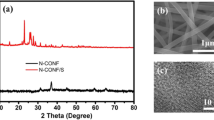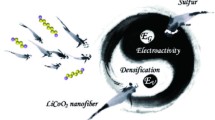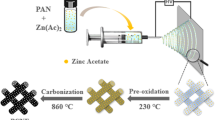Abstract
The development of sulfur cathode materials for lithium–sulfur (Li–S) batteries has significant technical challenges owing to poor conductivity and “shuttle effect” of the polysulfide dissolution. In recently, many efforts have been made to improve the electrochemical performance of cathode materials for Li–S batteries. In the present investigation, MgO-doped and nitrogen-rich carbon nanofibers have been prepared via electrospinning technology under carbonization treatment. Ultrathin ZnO nanolayer is further coated on the surface of the carbon nanofiber by atomic layer deposition and then sulfur is loaded inside the nanofibers to achieve a C–MgO/S@ZnO composite. This composite was used as cathode material in Li–S batteries. They are exhibited maximum rate capabilities of 1066.08 and 846.75 mA h g−1 at 0.5 and 2 C, respectively. Moreover, the discharge capacity is 812.67 mA h g−1 after 100 cycles at 2 C and the capacity decay after 100 cycles is as small as 0.04% per cycle. The excellent electrochemical performance of C–MgO/S@ZnO nanofibers could be ascribed by the rational design due to the structure and composition of sulfur host.








Similar content being viewed by others
References
Xu R, Belharouak I, Zhang X et al (2014) Insight into sulfur reactions in Li–S batteries. ACS Appl Mater Interfaces 6(24):21938–21945
Manthiram A, Fu Y, Su YS (2013) Challenges and prospects of lithium–sulfur batteries. Acc Chem Res 46(5):1125–1134
Zhang J, Cai Y, Wu J, Yao J (2015) Graphene oxide-confined synthesis of Li4Ti5O12 microspheres as high-performance anodes for lithium ion batteries. Electrochim Acta 165:422–429
Zhang J, Cai Y, Zhong Q et al (2015) Porous nitrogen-doped carbon derived from silk fibroin protein encapsulating sulfur as a superior cathode material for high-performance lithiu. Nanoscale 7(42):17791–17797
Li Y, Cai Y, Cai Z et al (2018) Sulfur-in filtrated yeast-derived nitrogen-rich porous carbon microspheres@reduced graphene cathode for high-performance lithium–sulfur batteries. Electrochim Acta 285:317–325
Huang JQ, Huang J, Chong WG et al (2019) Graphene/RuO2 nanocrystal composites as sulfur host for lithium–sulfur batteries. J Energy Chem 35:204–211
Guo J, Xu Y, Wang C (2011) Sulfur-impregnated disordered carbon nanotubes cathode for lithium–sulfur batteries. Nano Lett 11(10):4288–4294
Lin T, Tang Y, Wang Y et al (2013) Scotch-tape-like exfoliation of graphite assisted with elemental sulfur and graphene-sulfur composites for high-performance lithium–sulfur batteries. Energy Environ Sci 6(4):1283–1290
Cao J, Chen C, Zhao Q et al (2016) A flexible nanostructured paper of a reduced graphene oxide–sulfur composite for high-performance lithium–sulfur batteries with unconventional configurations. Adv Mater 28(43):9629–9636
Wang D, Li F, Liu M et al (2008) 3D aperiodic hierarchical porous graphitic carbon material for high-rate electrochemical capacitive energy storage. Angew Chem Int Ed 47(2):373–376
Mao Y, Li G, Guo Y et al (2017) Foldable interpenetrated metal-organic frameworks/carbon nanotubes thin film for lithium–sulfur batteries. Nat Commun 8:1–8
Yang W, Yang W, Song A et al (2018) 3D interconnected porous carbon nanosheets/carbon nanotubes as a polysulfide reservoir for high performance lithium–sulfur batteries. Nanoscale 10(2):816–824
Fu Y, Zu C, Manthiram A (2013) In situ-formed Li2S in lithiated graphite electrodes for lithium–sulfur batteries. J Am Chem Soc 135(48):18044–18047
Ye J, He F, Nie J et al (2015) Sulfur/carbon nanocomposite-filled polyacrylonitrile nanofibers as a long life and high capacity cathode for lithium–sulfur batteries. J Mater Chem A 3(4):7406–7412
Mi K, Jiang Y, Feng J et al (2016) Hierarchical carbon nanotubes with a thick microporous wall and inner channel as efficient scaffolds for lithium–sulfur Batteries. Adv Funct Mater 26(10):1571–1579
Yuan L, Yuan H, Qiu X et al (2009) Improvement of cycle property of sulfur-coated multi-walled carbon nanotubes composite cathode for lithium/sulfur batteries. J Power Sources 189(2):1141–1146
Liu J, Qu W, Xie Y et al (2017) Thermal conductivity and annealing effect on structure of lignin-based microscale carbon fibers. Carbon 121:35–47
Liang X, Zhang M, Kaiser MR et al (2015) Split-half-tubular polypyrrole@sulfur@polypyrrole composite with a novel three-layer-3D structure as cathode for lithium/sulfur batteries. Nano Energy 11:587–599
Xiao L, Cao Y, Xiao J et al (2012) A soft approach to encapsulate sulfur: polyaniline nanotubes for lithium–sulfur batteries with long cycle life. Adv Mater 24(9):1176–1181
Li Y, Shi B, Liu W et al (2018) Hollow polypyrrole@MnO2 spheres as nano-sulfur hosts for improved lithium–sulfur batteries. Electrochim Acta 260:912–920
Liu X, Huang JQ, Zhang Q, Mai L (2017) Nanostructured metal oxides and sulfides for lithium–sulfur batteries. Adv Mater 29(20):1601759–1–1601759–25
Choi YJ, Jung BS, Lee DJ et al (2007) Electrochemical properties of sulfur electrode containing nano Al2O3 for lithium/sulfur cell. Phys Scr T129:62–65
Zhou G, Yin LC, Wang DW et al (2013) Fibrous hybrid of graphene and sulfur nanocrystals for high-performance lithium–sulfur batteries. ACS Nano 7(6):5367–5375
Seh ZW, Li W, Cha JJ et al (2013) Sulphur–TiO2 yolk-shell nanoarchitecture with internal void space for long-cycle lithium–sulphur batteries. Nat Commun 4:1–6
An D, Shen L, Lei D et al (2019) An ultrathin and continuous Li4Ti5O12 coated carbon nanofiber interlayer for high rate lithium sulfur battery. J Energy Chem 31:19–26
Kong L, Chen X, Li BQ et al (2018) A bifunctional perovskite promoter for polysulfide regulation toward stable lithium–sulfur batteries. Adv Mater 30(2):1–7
Zhong M, Yang D, Xie C et al (2016) Yolk–shell MnO@ZnMn2O4/N–C nanorods derived from α-MnO2/ZIF-8 as anode materials for lithium ion Batteries. Small 12(40):5564–5571
Marichy C, Bechelany M, Pinna N (2012) Atomic layer deposition of nanostructured materials for energy and environmental applications. Adv Mater 24(8):1017–1032
Zhou T, Jiang Q, Wang L et al (2018) Facile preparation of nitrogen-enriched hierarchical porous carbon nanofibers by Mg(OAc)2-assisted electrospinning for flexible supercapacitors. Appl Surf Sci 456:827–834
Manthiram A, Fu Y, Chung S-H et al (2014) Rechargeable lithium–sulfur batteries. Chem Rev 114(23):11751–11787
Zheng G, Yang Y, Cha JJ et al (2011) Hollow carbon nanofiber-encapsulated sulfur cathodes for high specific capacity rechargeable lithium batteries. Nano Lett 11(10):4462–4467
Zheng Z, Guo H, Pei F et al (2016) High sulfur loading in hierarchical porous carbon rods constructed by vertically oriented porous graphene-like nanosheets for Li–S batteries. Adv Funct Mater 26(48):8952–8959
Luo C, Niu S, Zhou G et al (2016) Dual-functional hard template directed one-step formation of a hierarchical porous carbon-carbon nanotube hybrid for lithium–sulfur batteries. Chem Commun 52(82):12143–12146
Xiao Z, Yang Z, Wang L et al (2015) A lightweight TiO2/Graphene interlayer, applied as a highly effective polysulfide absorbent for fast, long-life lithium–sulfur batteries. Adv Mater 27(18):2891–2898
Zhang YB, Yan Y, Xie JC et al (2018) Ionothermal synthesis of graphene-based microporous carbon for lithium–sulfur batteries. New J Chem 42(4):2483–2490
Ma F, Liang J, Wang T et al (2018) Efficient entrapment and catalytic conversion of lithium polysulfides on hollow metal oxide submicro-spheres as lithium–sulfur battery cathodes. Nanoscale 10(12):5634–5641
Gu X, Tong CJ, Wen B et al (2016) Ball-milling synthesis of ZnO@sulphur/carbon nanotubes and Ni(OH)2@sulphur/carbon nanotubes composites for high-performance lithium–sulphur batteries. Electrochim Acta 196:369–376
Zhou J, Qin J, Guo L et al (2016) Scalable synthesis of high-quality transition metal dichalcogenide nanosheets and their application as sodium-ion battery anodes. J Mater Chem A 4(44):17370–17380
Guo Y, Wu H, Zhang Y et al (2017) Vesicle-like sulfur/reduced graphene oxide composites for high performance lithium–sulfur batteries. J Alloy Compd 724:1007–1013
Liu Y, Guo J, Zhang J et al (2015) Graphene-wrapped sulfur nanospheres with ultra-high sulfur loading for high energy density lithium–sulfur batteries. Appl Surf Sci 324:399–404
Yu M, Ma J, Song H et al (2016) Atomic layer deposited TiO2 on a nitrogen-doped graphene/sulfur electrode for high performance lithium–sulfur batteries. Energy Environ Sci 9(4):1495–1503
Yang R, Du H, Lin Z et al (2019) ZnO nanoparticles filled tetrapod-shaped carbon shell for lithium–sulfur batteries. Carbon 141:258–265
Zhu C, Kim C, Aoki Y, Habazaki H (2017) Nitrogen-Doped hierarchical porous carbon architecture incorporated with cobalt nanoparticles and carbon nanotubes as efficient electrocatalyst for oxygen reduction reaction. Adv Mater Interfaces 4(19):1700583–1–1700583–11
Wu J, Hu J, Song K et al (2017) Spirulina-derived nitrogen-doped porous carbon as carbon/S composite cathodes for high cyclability lithium–sulphur batteries. J Alloys Compd 704:1–6
Xiang M, Wu H, Liu H et al (2017) A flexible 3D multifunctional MgO-decorated carbon foam@CNTs hybrid as self-supported cathode for high-performance lithium–sulfur batteries. Adv Funct Mater 27(37):1–13
Maffeis TGG, Penny MW, Castaing A et al (2012) XPS investigation of vacuum annealed vertically aligned ultralong ZnO nanowires. Surf Sci 606(1–2):99–103
Wu J, Li S, Yang P et al (2019) S@TiO2 nanospheres loaded on PPy matrix for enhanced lithium–sulfur batteries. J Alloys Compd 783:279–285
Liang X, Hart C, Pang Q et al (2015) A highly efficient polysulfide mediator for lithium–sulfur batteries. Nat Commun 6:1–8
Wei H, Rodriguez EF, Best AS et al (2017) Chemical bonding and physical trapping of sulfur in mesoporous magnéli Ti4O7 microspheres for high-performance Li–S battery. Adv Energy Mater 7(4):1601616–1–1601616–10
Zhao T, Ye Y, Peng X et al (2016) Advanced lithium–sulfur batteries enabled by a bio-inspired polysulfide adsorptive brush. Adv Funct Mater 26(46):8418–8426
Acknowledgements
This research work was financially supported by Zhejiang Science and Technology Innovation Activity Plan (Newmiao Talents Program) for College Students (2018R406066) and the Fundamental Research Funds of Zhejiang Sci-Tech University (2019Y006). The authors like to thank Dr. Jegatheeswaran Sonamuthu and Ms. Hongmei Li for their worthy suggestions about this research investigations and manuscript writing.
Author information
Authors and Affiliations
Corresponding author
Additional information
Publisher's Note
Springer Nature remains neutral with regard to jurisdictional claims in published maps and institutional affiliations.
Electronic supplementary material
Below is the link to the electronic supplementary material.
Rights and permissions
About this article
Cite this article
Ma, D., Zhu, R., Ruan, F. et al. Rational design of hierarchical C–MgO@ZnO nanofiber as sulfur host for high-performance lithium–sulfur batteries. J Mater Sci 55, 5534–5544 (2020). https://doi.org/10.1007/s10853-020-04390-3
Received:
Accepted:
Published:
Issue Date:
DOI: https://doi.org/10.1007/s10853-020-04390-3




